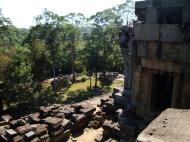Ta Keo Temple / Mountain
Name: Ta Keo
Creator: Jayavarman V and Jayaviravarman
Date built: around 1000 CE
Primary deity: Shiva
Architecture: Khleang style
Location: between the Gate of Victory of Angkor Thom and East Baray
Coordinates: 13.435473°N 103.920452°ETa Keo had to be the state temple of Jayavarman V, son of Rajendravarman, who had built Pre Rup. Like Pre Rup, it has five sanctuary towers arranged in a quincunx, built on the uppermost level of five-tier pyramid consisting of overlapping terraces (a step pyramid), surrounded by moat, as a symbolic depiction of Mount Meru.
Its particularly massive appearance is due to the absence of external decorations, as carving had just begun when the works stopped, besides an elaborate use of perspective effects. The main axis of the temple is E-W and a causeway 500 meters long connects its eastern entrance to a landing stage on the Eastern Baray, with which Ta Keo was in tightly relationship. The outer banks of the surrounding moats, which have now vanished, measured 255 m by 195 m. The first terrace is 122 m by 106 m, its wall of sandstone on laterite basis constitutes the outer enclosure.
Each of the first two terraces has a gopura at the four cardinal points. Each gopura has three independent passages and a central tower with diminishing tiers.
A continuous gallery (1.4 m width) constitutes the inner enclosure of the second terrace.
Before Ta Keo (e.g. in Pre Rup) there were long buildings that followed the length of enclosures with some discontinuity.
Along the eastern side of the second terrace in the corners there are two buildings that are the shorter version of the long galleries of the first terrace. Its base is 60 m square, the summit is 47 m square and stands 21.5 m above the ground. The four stairways that lead on the summit are continuous and very steep. At the foot of the eastern one there is a statue of a kneeling Nandi, which confirms that Ta Keo was a Shivaite temple. The absence of any decoration makes the final pyramid really massive. On the east face some damaged carvings of floral patterns are still visible. The four corner towers on the summit stand on 0.8 m high basements and open to the four cardinal points with protruding vestibules. In the central tower, which dominates the others from its basement 4 meters high, the vestibules are doubled. The central tower reaches a height of 45 meters.
Jayavarman V
Jayavarman V was ten year old when succeeded to his father, Rajendravarman, in 968 A.D. His early years of reign were rather turbulent and the court officials dominated the royal politics. When he was aged seventeen (in 975 AD), he began the construction of his own state temple, whose modern name is Ta Keo, that was dedicated some time around 1000 AD. Yogisvarapandita, a high priest who became minister of Suryavarman I and received the temple from him many years later, says in inscriptions that a lightning strike hit the unfinished building, an evil omen, so the works stopped. Maybe works stopped simply because of the death of Jayavarman V, as there was a struggle for succession.
However the temple worked continuously as a cult center until the 13th century, and even Yogisvarapandita worshipped the shrines at the first levels of the temple.
A term tightly linked to Hemasringagiri is Jayendranagari (which in Sanskrit means 'capital of the victorious king'), the royal palace or maybe the new capital city of Jayavarman V. Today only a tower in the south-west survives, similar to the corner towers of Ta Keo, with an unusual single door to the south. Sometime during his reign, Jayavarman took up residence on the east side of the East Baray, and moved the capital to the west bank. Around the year 975, work was begun on Ta Keo temple in the center of the new capital. Ta Keo was actually called 'Hemasringagiri' or 'the mountain with golden peaks,' meaning Mount Meru-the sacred peak of Indian lore.
Its base measures 122 by 106 meters, while the outer moat stretched 255 by 195 meters, but has now vanished. Work on the temple ceased, although artisans had only begun carving the decorative work at the base of the temple.
For unknown reasons, the king donated the temple to his minister Yogisvarapandita, who had served under the former king. Yogisvarapandita worshipped only the shrines at the base of the temple, since he was prohibited by law from worshipping at a higher level than the king.
Ta Keo Temple / Mountain, Siem Reap, Cambodia Map
 Editor for Asisbiz: Matthew Laird Acred
Editor for Asisbiz: Matthew Laird Acred
If you love our website please add a like on facebook
Please donate so we can make this site even better !!















































